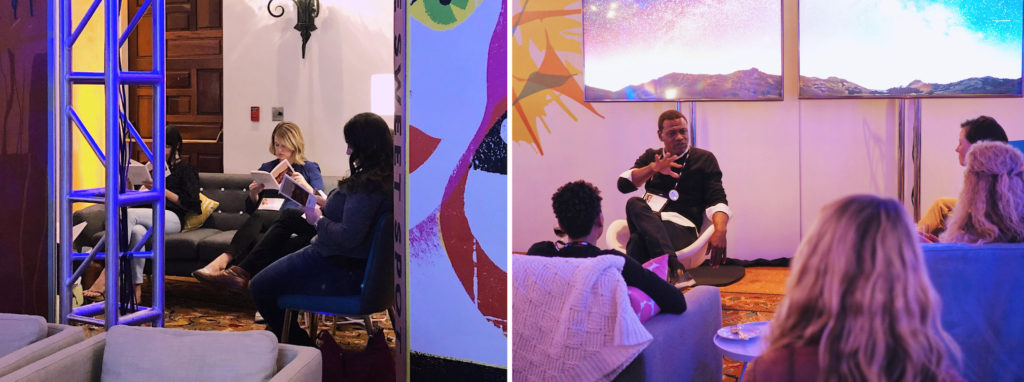Using narrative to develop a shared vision of the future
A Princeton University neuroscience researcher found that stories, especially the ones where the storyteller and audience find common ground, trigger an alignment in brain activity. The human brain is wired for storytelling.
“Take Us to a Better Place,” a new fiction anthology published by the Robert Wood Johnson Foundation, aims to “spark conversations about a Culture of Health — and how we might get there.” In 2018, TEDMED attendees previewed several stories from the collection and discussed topics like climate change and gentrification with the authors. At the conference, readers told us that these stories about individual characters in specific situations helped them engage in deeper, more meaningful discussions than they might have had otherwise.

TEDMED 2018 attendees previewed short stories from RWJF’s “Take Us to a Better Place” anthology. Authors, including Calvin Baker (pictured at right), discussed their stories with readers.
Storytelling is critically important in unexpected places, where real humans and their experiences aren’t always included in conversations. This month, patient advocate Jen Horonjeff made waves during the J.P. Morgan Healthcare Conference when she appeared on stage in a hospital gown. Her efforts “highlight the power imbalance between decision-makers and end users” and made invisible patient stories more visible at an industry event.
Stories don’t have to be epic to make an impact. In fact, stories about small moments can be the most effective way to connect with a big idea. Luminary Labs CEO Sara Holoubek shared her own perspective-shifting moment from last week’s HT4M event, where a brief encounter in the hallway added context and clarity to a larger discussion about medical reparations.
Human-centered stories are tools that any industry can use to communicate with stakeholders and develop a shared vision of the future. In 2018, we compiled our own list of sci-fi and speculative fiction stories that could help leaders imagine unintended consequences of emerging technologies. Since then, we’ve noticed several projects that use fiction to initiate conversations about the future:
- Doteveryone’s Women Invent the Future is “an experimental anthology … to challenge how technology is imagined.”
- Nesta collaborated with author Tim Maughan on Future Londoners, a project that envisions how imaginary characters might experience urban life in 2023.
- Future Tense, a partnership between Slate, New America, and Arizona State University, pairs fiction with response essays from experts, bringing additional context to stories about technology, policy, and society.
- The New York Times’ Op-Eds From the Future asks authors and futurists to imagine “the Op-Eds we might read 10, 20, or even 100 years from now.” Section editor Susan Fowler said “Science fiction is so powerful and effective because it takes the problems and issues we face today and puts them into new situations and contexts, allowing us to see them more clearly.”
- Better Worlds, published by the Verge, is a series of fictional stories with a “throughline of hope.” Introducing the series, Culture Editor Laura Hudson said “whenever we imagine a more equitable, sustainable, or humane world, we are producing speculative fiction, and this creates a ‘vital space’ that is essential to forward progress.”
- Amazon’s Warmer, an online collection of “cli-fi” stories, asks readers to reckon with environmental crisis and empathize with future generations.
- How We Get To Next, a nonprofit digital publication funded in part by the Bill & Melinda Gates Foundation, indexed nine sci-fi subgenres — from Afrofuturism to “Woke Space Operas” — that could help us better understand the future.
What stories have made you think differently about your work? Send your suggestions to editor@luminary-labs.com.
We share updates and insights — including reading recommendations — in our weekly newsletter: subscribe to the Lab Report.


